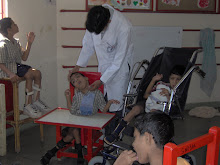Surgery for cleft lip and palate has come a long way over the past 50 years. From the early days of the twentieth century when only clefts of the lip were repaired and palates left open, to the early days of this century when surgeons are hoping to operate upon the cleft inside the mother's womb. All over the developing world organizations such as "The Smile Train" and "Interplast" are providing free surgical care to children with cleft lip and palate. This has resulted in a never before seen access to cleft surgery all over the world.
Most surgeons would agree that the minimum age to perform surgery would be around 3 -4 months. However the mangement of the child begins at birth. While a surgeon cannot operate until the child is old enough, his job is a lot easier if the distance between the two ends of the cleft was reduced. One of the most effective means of literally 'bridging the gap' is nasoalveolar molding.
Nasoalveolar Molding
In 1995 an American Orthodontist named Barry
 Grayson introduced a technique called naso-alveolar molding. Put simply, the technique uses a plate that holds the segments of the cleft together. Elastics are then attached to the appliance, which are then taped to the child's face. The child is required to wear the appliance continuously until she/he is ready for surgery.
Grayson introduced a technique called naso-alveolar molding. Put simply, the technique uses a plate that holds the segments of the cleft together. Elastics are then attached to the appliance, which are then taped to the child's face. The child is required to wear the appliance continuously until she/he is ready for surgery.Nasoalveolar molding is by no means the first method tried to mold the cleft before surgery but it is by far the most successful. Traditional appliances
 relied on using a variety of active forces such as pins and screws to force the segments closer to each other. The risk with these appliances was that the surgeon could push too far or too fast, thus risking the health of child's bone.
relied on using a variety of active forces such as pins and screws to force the segments closer to each other. The risk with these appliances was that the surgeon could push too far or too fast, thus risking the health of child's bone.Despite it's apparent rigidity, bone is actually a very plastic tissue. When an optimum force is applied, the pattern in which bone is laid down changes, thus causing a change in the shape of bone. Orthodontists have used this property of bone for years, reshaping bone to straighten or move teeth. But every orthodontist is aware that an excess of force will stop blood flow to the bone causing the death of the bone or necrosis.
Nasoalveolar molding makes use of the concept that for the first 28 days after the child is born, the child's blood cont ains traces of the maternal hormone estrogen. The hormone, which is the
female sex hormone has an all together different role in the child. Maternal estrogen makes the bones and cartilage of the child flexible, thereby ensuring that the skeleton does not suffer any damage during delivery. When the bones are molded in this state, the dentist can acheive a great amount of bone closure with minimal chances of adverse effects. Nasoalveolar molding acheives the best results when started in the first three weeks of life.
There is another reason for the early initiation of pre-surgical orthopedic treatment. Children with cleft palate often have problems feeding. Most children develop an alternative method of swallowing by the time they are three months old. A plate in the child's mouth can prevent this alternate swallowing pattern if given early. If the plate is given after the child has adapted to it's alternate swallowing pattern the plate is viewed as a foreign object and the child may have a very uncomfortable time adjusting to the plate.
In most Western countries integrated cleft care involves a well co-ordinated multidisciplinary team of professionals. In such a setup the child is directed towards presurgical care soon after she is born. In India however, even with access to surgical care the awareness of presurgical techniques is low. The absence of any co-ordinated multidisciplinary effort means that the child is , if ever, referred for presurgical care only after three or four months. That in my opinion is three or four months too late!
Some but not all cleft centers in India practice nasoalveolar molding. Do ask about nasoalveolar molding when you take your child for a preliminary checkup. To find out where your nearest free cleft center in India is located click on the links below
www.smiletrainindia.org/treatment_centers.php
www.interplast.org/programs/where_we_work.html








No comments:
Post a Comment